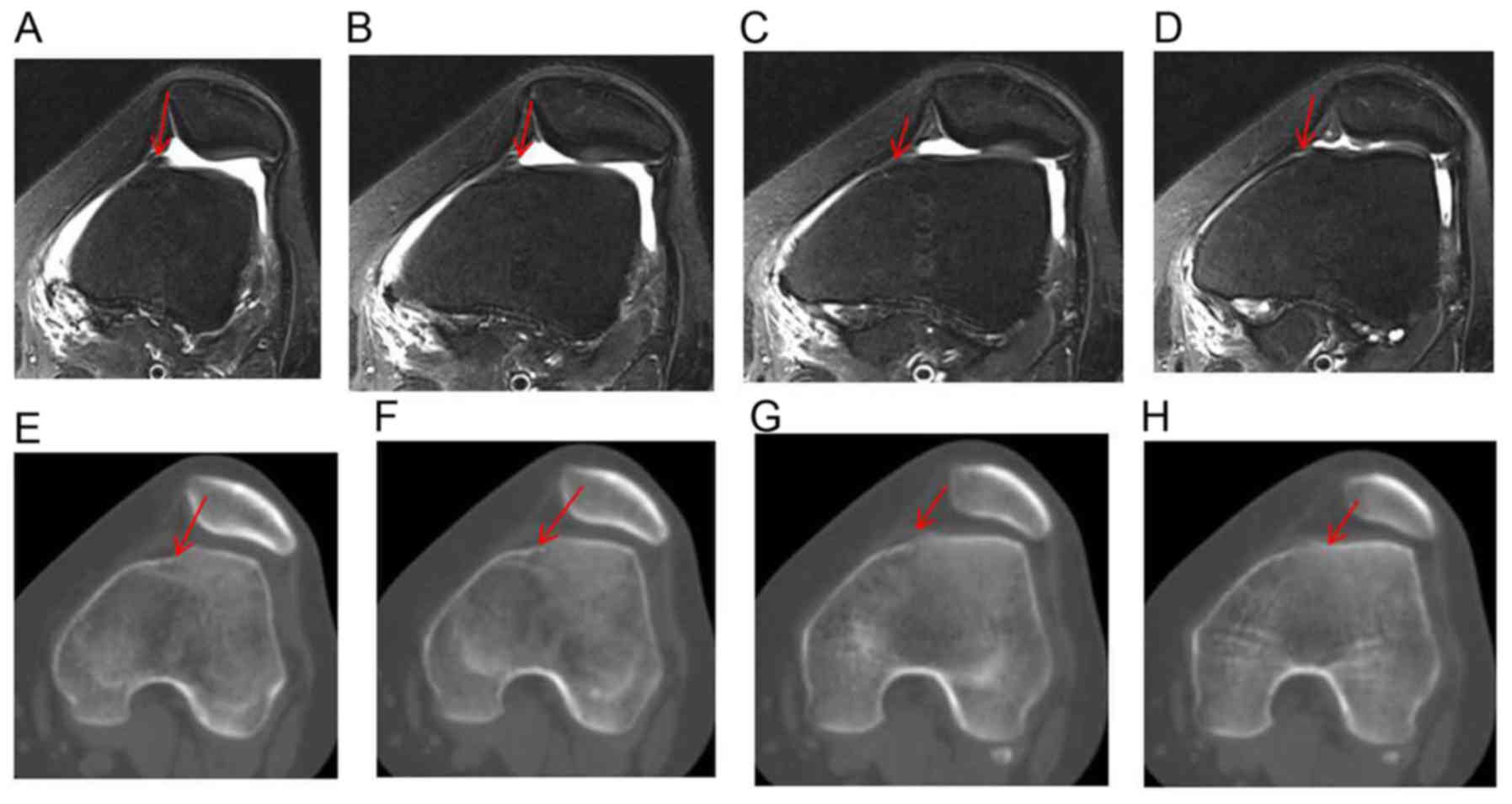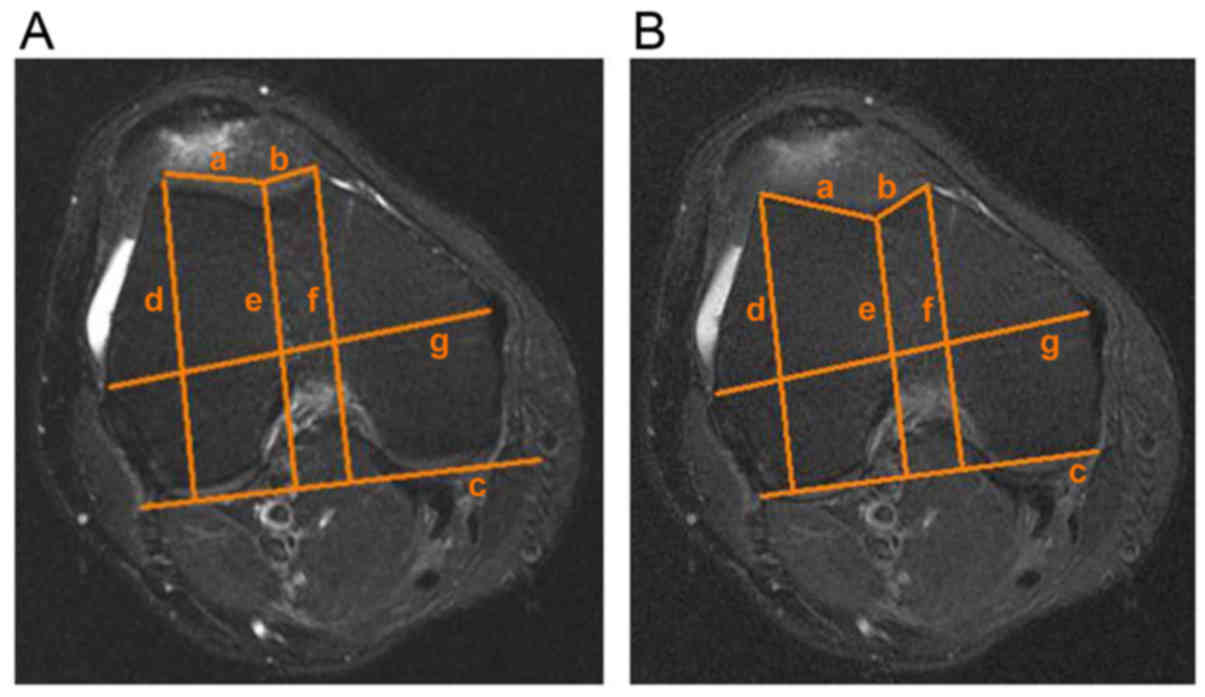|
1
|
Earhart C, Patel DB, White EA, Gottsegen
CJ, Forrester DM and Matcuk GR Jr: Transient lateral patellar
dislocation: Review of imaging findings, patellofemoral anatomy,
and treatment options. Emerg Radiol. 20:11–23. 2013. View Article : Google Scholar : PubMed/NCBI
|
|
2
|
Dejour H, Walch G, Nove-Josserand L and
Guier C: Factors of patellar instability: An anatomic radiographic
study. Knee Surg Sports Traumatol Arthrosc. 2:19–26. 1994.
View Article : Google Scholar : PubMed/NCBI
|
|
3
|
Lippacher S, Reichel H and Nelitz M:
Radiological criteria for trochlear dysplasia in children and
adolescents. J Pediatr Orthop B. 20:341–344. 2011. View Article : Google Scholar : PubMed/NCBI
|
|
4
|
Redziniak DE, Diduch DR, Mihalko WM,
Fulkerson JP, Novicoff WM, Sheibani-Rad S and Saleh KJ: Patellar
instability. Instr Course Lect. 59:195–206. 2010.PubMed/NCBI
|
|
5
|
Botchu R, Obaid H and Rennie WJ:
Correlation between trochlear dysplasia and the notch index. J
Orthop Surg (Hong Kong). 21:290–293. 2013. View Article : Google Scholar : PubMed/NCBI
|
|
6
|
Chhabra A, Subhawong TK and Carrino JA: A
systematised MRI approach to evaluating the patellofemoral joint.
Skeletal Radiol. 40:375–387. 2011. View Article : Google Scholar : PubMed/NCBI
|
|
7
|
Dejour D and Le Coultre B: Osteotomies in
patello-femoral instabilities. Sports Med Arthrosc. 15:39–46. 2007.
View Article : Google Scholar : PubMed/NCBI
|
|
8
|
Tecklenburg K, Dejour D, Hoser C and Fink
C: Bony and cartilaginous anatomy of the patellofemoral joint. Knee
Surg Sports Traumatol Arthrosc. 14:235–240. 2006. View Article : Google Scholar : PubMed/NCBI
|
|
9
|
Nelitz M, Lippacher S, Reichel H and
Dornacher D: Evaluation of trochlear dysplasia using MRI:
Correlation between the classification system of Dejour and
objective parameters of trochlear dysplasia. Knee Surg Sports
Traumatol Arthrosc. 22:120–127. 2014. View Article : Google Scholar : PubMed/NCBI
|
|
10
|
Smith TO, Cogan A, Patel S, Shakokani M,
Toms AP and Donell ST: The intra- and inter-rater reliability of
X-ray radiological measurements for patellar instability. Knee.
20:133–138. 2013. View Article : Google Scholar : PubMed/NCBI
|
|
11
|
Escala JS, Mellado JM, Olona M, Giné J,
Sauri A and Neyret P: Objective patellar instability: MR-based
quantitative assessment of potentially associated anatomical
features. Knee Surg Sports Traumatol Arthrosc. 14:264–272. 2006.
View Article : Google Scholar : PubMed/NCBI
|
|
12
|
Stefanik JJ, Roemer FW, Zumwalt AC, Zhu Y,
Gross KD, Lynch JA, Frey-Law LA, Lewis CE, Guermazi A, Powers CM
and Felson DT: Association between measures of trochlear morphology
and structural features of patellofemoral joint osteoarthritis on
MRI: The MOST study. J Orthop Res. 30:1–8. 2012. View Article : Google Scholar : PubMed/NCBI
|
|
13
|
Keser S, Savranlar A, Bayar A, Ege A and
Turhan E: Is there a relationship between anterior knee pain and
femoral trochlear dysplasia? Assessment of lateral trochlear
inclination by magnetic resonance imaging. Knee Surg Sports
Traumatol Arthrosc. 16:911–915. 2008. View Article : Google Scholar : PubMed/NCBI
|
|
14
|
Nelitz M and Lippacher S: Arthroscopic
evaluation of trochlear dysplasia as an aid in decision making for
the treatment of patellofemoral instability. Knee Surg Sports
Traumatol Arthrosc. 22:2788–2794. 2014. View Article : Google Scholar : PubMed/NCBI
|
|
15
|
Biedert RM and Bachmann M:
Anterior-posterior trochlear measurements of normal and dysplastic
trochlea by axial magnetic resonance imaging. Knee Surg Sports
Traumatol Arthrosc. 17:1225–1230. 2009. View Article : Google Scholar : PubMed/NCBI
|
|
16
|
Toms AP, Cahir J, Swift L and Donell ST:
Imaging the femoral sulcus with ultrasound, CT, and MRI:
Reliability and generalizability in patients with patellar
instability. Skeletal Radiol. 38:329–338. 2009. View Article : Google Scholar : PubMed/NCBI
|
|
17
|
van Huyssteen AL, Hendrix MR, Barnett AJ,
Wakeley CJ and Eldridge JD: Cartilage-bone mismatch in the
dysplastic trochlea. An MRI study. J Bone Joint Surg Br.
88:688–691. 2006. View Article : Google Scholar : PubMed/NCBI
|
|
18
|
Charles MD, Haloman S, Chen L, Ward SR,
Fithian D and Afra R: Magnetic resonance imaging-based
topographical differences between control and recurrent
patellofemoral instability patients. Am J Sports Med. 41:374–384.
2013. View Article : Google Scholar : PubMed/NCBI
|
|
19
|
Köhlitz T, Scheffler S, Jung T, Hoburg A,
Vollnberg B, Wiener E and Diederichs G: Prevalence and patterns of
anatomical risk factors in patients after patellar dislocation: A
case control study using MRI. Eur Radiol. 23:1067–1074. 2013.
View Article : Google Scholar : PubMed/NCBI
|
|
20
|
Kamath AF, Slattery TR, Levack AE, Wu CH,
Kneeland JB and Lonner JH: Trochlear inclination angles in normal
and dysplastic knees. J Arthroplasty. 28:214–219. 2013. View Article : Google Scholar : PubMed/NCBI
|
|
21
|
Balcarek P, Jung K, Ammon J, Walde TA,
Frosch S, Schüttrumpf JP, Stürmer KM and Frosch KH: Anatomy of
lateral patellar instability: Trochlear dysplasia and tibial
tubercle-trochlear groove distance is more pronounced in women who
dislocate the patella. Am J Sports Med. 38:2320–2327. 2010.
View Article : Google Scholar : PubMed/NCBI
|
|
22
|
Teng HL, Chen YJ and Powers CM: Predictors
of patellar alignment during weight bearing: An examination of
patellar height and trochlear geometry. Knee. 21:142–146. 2014.
View Article : Google Scholar : PubMed/NCBI
|
|
23
|
Van Haver A, De Roo K, De Beule M, Van
Cauter S, Audenaert E, Claessens T and Verdonk P: Semi-automated
landmark-based 3D analysis reveals new morphometric characteristics
in the trochlear dysplastic femur. Knee Surg Sports Traumatol
Arthrosc. 22:2698–2708. 2014. View Article : Google Scholar : PubMed/NCBI
|
|
24
|
Hing CB, Shepstone L, Marshall T and
Donell ST: A laterally positioned concave trochlear groove prevents
patellar dislocation. Clin Orthop Relat Res. 447:187–194. 2006.
View Article : Google Scholar : PubMed/NCBI
|
|
25
|
Shih YF, Bull AM and Amis AA: The
cartilaginous and osseous geometry of the femoral trochlear groove.
Knee Surg Sports Traumatol Arthrosc. 12:300–306. 2004. View Article : Google Scholar : PubMed/NCBI
|
|
26
|
Fucentese SF, Zingg PO, Schmitt J,
Pfirrmann CW, Meyer DC and Koch PP: Classification of trochlear
dysplasia as predictor of clinical outcome after trochleoplasty.
Knee Surg Sports Traumatol Arthrosc. 19:1655–1661. 2011. View Article : Google Scholar : PubMed/NCBI
|
|
27
|
Howells NR, Barnett AJ, Ahearn N, Ansari A
and Eldridge JD: Medial patellofemoral ligament reconstruction: A
prospective outcome assessment of a large single centre series. J
Bone Joint Surg Br. 94:1202–1208. 2012. View Article : Google Scholar : PubMed/NCBI
|
|
28
|
Dejour D, Byn P and Ntagiopoulos PG: The
Lyon's sulcus-deepening trochleoplasty in previous unsuccessful
patellofemoral surgery. Int Orthop. 37:433–439. 2013. View Article : Google Scholar : PubMed/NCBI
|
|
29
|
Dornacher D, Reichel H and Lippacher S:
Measurement of tibial tuberosity-trochlear groove distance:
Evaluation of inter- and intraobserver correlation dependent on the
severity of trochlear dysplasia. Knee Surg Sports Traumatol
Arthrosc. 22:2382–2387. 2014. View Article : Google Scholar : PubMed/NCBI
|

















